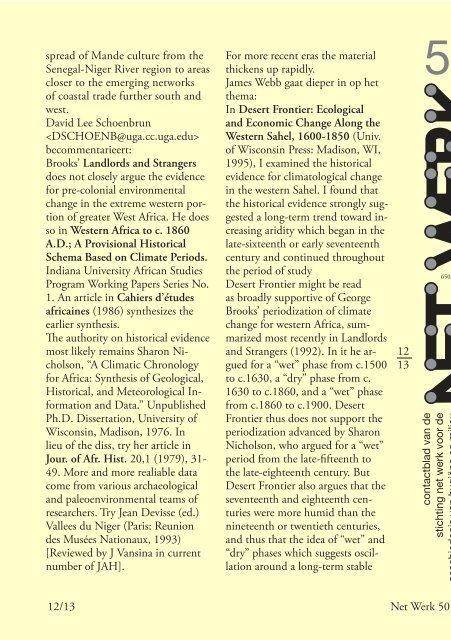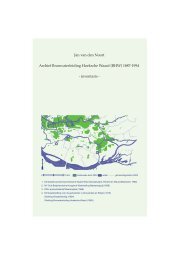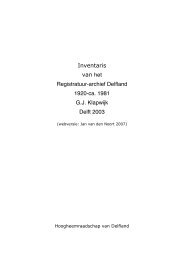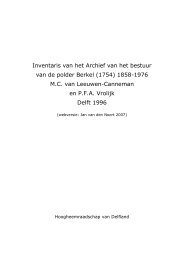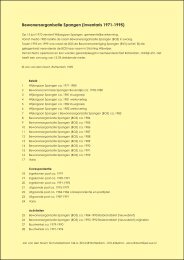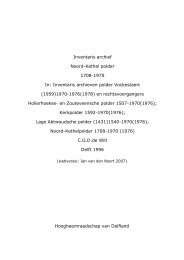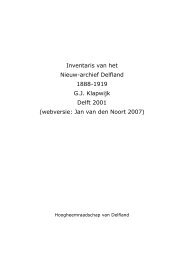Net Werk voor de Geschiedenis van Hygiëne en Milieu, 1994-1996 ...
Net Werk voor de Geschiedenis van Hygiëne en Milieu, 1994-1996 ...
Net Werk voor de Geschiedenis van Hygiëne en Milieu, 1994-1996 ...
You also want an ePaper? Increase the reach of your titles
YUMPU automatically turns print PDFs into web optimized ePapers that Google loves.
spread of Man<strong>de</strong> culture from the<br />
S<strong>en</strong>egal-Niger River region to areas<br />
closer to the emerging networks<br />
of coastal tra<strong>de</strong> further south and<br />
west.<br />
David Lee Scho<strong>en</strong>brun<br />
<br />
becomm<strong>en</strong>tarieert:<br />
Brooks’ Landlords and Strangers<br />
does not closely argue the evi<strong>de</strong>nce<br />
for pre-colonial <strong>en</strong>vironm<strong>en</strong>tal<br />
change in the extreme western portion<br />
of greater West Africa. He does<br />
so in Western Africa to c. 1860<br />
A.D.; A Provisional Historical<br />
Schema Based on Climate Periods.<br />
Indiana University African Studies<br />
Program Working Papers Series No.<br />
1. An article in Cahiers d’étu<strong>de</strong>s<br />
africaines (1986) synthesizes the<br />
earlier synthesis.<br />
Th e authority on historical evi<strong>de</strong>nce<br />
most likely remains Sharon Nicholson,<br />
“A Climatic Chronology<br />
for Africa: Synthesis of Geological,<br />
Historical, and Meteorological Information<br />
and Data.” Unpublished<br />
Ph.D. Dissertation, University of<br />
Wisconsin, Madison, 1976. In<br />
lieu of the diss, try her article in<br />
Jour. of Afr. Hist. 20,1 (1979), 31-<br />
49. More and more realiable data<br />
come from various archaeological<br />
and paleo<strong>en</strong>vironm<strong>en</strong>tal teams of<br />
researchers. Try Jean Devisse (ed.)<br />
Vallees du Niger (Paris: Reunion<br />
<strong>de</strong>s Musées Nationaux, 1993)<br />
[Reviewed by J Vansina in curr<strong>en</strong>t<br />
number of JAH].<br />
12/13<br />
For more rec<strong>en</strong>t eras the material<br />
thick<strong>en</strong>s up rapidly.<br />
James Webb gaat dieper in op het<br />
thema:<br />
In Desert Frontier: Ecological<br />
and Economic Change Along the<br />
Western Sahel, 1600-1850 (Univ.<br />
of Wisconsin Press: Madison, WI,<br />
1995), I examined the historical<br />
evi<strong>de</strong>nce for climatological change<br />
in the western Sahel. I found that<br />
the historical evi<strong>de</strong>nce strongly suggested<br />
a long-term tr<strong>en</strong>d toward increasing<br />
aridity which began in the<br />
late-sixte<strong>en</strong>th or early sev<strong>en</strong>te<strong>en</strong>th<br />
c<strong>en</strong>tury and continued throughout<br />
the period of study<br />
Desert Frontier might be read<br />
as broadly supportive of George<br />
Brooks’ periodization of climate<br />
change for western Africa, summarized<br />
most rec<strong>en</strong>tly in Landlords<br />
and Strangers (1992). In it he argued<br />
for a “wet” phase from c.1500<br />
to c.1630, a “dry” phase from c.<br />
1630 to c.1860, and a “wet” phase<br />
from c.1860 to c.1900. Desert<br />
Frontier thus does not support the<br />
periodization ad<strong>van</strong>ced by Sharon<br />
Nicholson, who argued for a “wet”<br />
period from the late-fi fte<strong>en</strong>th to<br />
the late-eighte<strong>en</strong>th c<strong>en</strong>tury. But<br />
Desert Frontier also argues that the<br />
sev<strong>en</strong>te<strong>en</strong>th and eighte<strong>en</strong>th c<strong>en</strong>turies<br />
were more humid than the<br />
ninete<strong>en</strong>th or tw<strong>en</strong>tieth c<strong>en</strong>turies,<br />
and thus that the i<strong>de</strong>a of “wet” and<br />
“dry” phases which suggests oscillation<br />
around a long-term stable<br />
12<br />
13<br />
50<br />
650-651<br />
contactblad <strong>van</strong> <strong>de</strong><br />
stichting net werk <strong>voor</strong> <strong>de</strong><br />
geschie<strong>de</strong>nis <strong>van</strong> hygiëne <strong>en</strong> milieu<br />
redactie: myriam d a r u<br />
webversie: jan <strong>van</strong> <strong>de</strong>n n o o r t<br />
<strong>Net</strong> <strong>Werk</strong> 50 - maart <strong>1996</strong><br />
mean obscures the fact that there<br />
was a long-term tr<strong>en</strong>d toward increasing<br />
aridity which characterized<br />
the period c.1600 to the pres<strong>en</strong>t.<br />
Desert Frontier argues that during<br />
the period 1600-1850 the<br />
long-term tr<strong>en</strong>d toward increasing<br />
aridity had a profound impact on<br />
both farming and herding peoples.<br />
In broad overview, the increasing<br />
aridity caused the expansion of the<br />
great camel zone, pushed the Sahelian<br />
cattle zone ever farther to the<br />
south, and rolled back the zone of<br />
rainfed agriculture. Th e <strong>de</strong>sertifi cation<br />
of the Sahel provoked transformations<br />
in ways of life. Early in this<br />
period, a new ethnic i<strong>de</strong>ntity, that<br />
of the “Whites” (Arabic: al-Bidan),<br />
was forged. Th e emerg<strong>en</strong>ce of this<br />
<strong>de</strong>sert-edge i<strong>de</strong>ntity was the result<br />
of many transformations in i<strong>de</strong>ntity<br />
among formerly Arab, Berber,<br />
Wolof, Soninke, Fuutanke, and<br />
Bafur groups. Th e <strong>de</strong>siccation of the<br />
<strong>de</strong>sert edge was accompanied by an<br />
increase in political viol<strong>en</strong>ce wh<strong>en</strong><br />
competition for scarcer resources<br />
int<strong>en</strong>sifi ed and new economic patterns<br />
came into being.<br />
In my original post on H-ASEH<br />
, I also<br />
m<strong>en</strong>tioned horse cavalry in the<br />
sahel in response to a post from<br />
W.M. Reger IV, a Russianist working<br />
on the Russian army, who was<br />
inquiring after other work on sev<strong>en</strong>te<strong>en</strong>th-c<strong>en</strong>tury<br />
<strong>en</strong>vironm<strong>en</strong>tal<br />
history and the impact of warfare<br />
and cavalry in specifi c. My work<br />
on Sahelian horse cavalry (fi rst<br />
published in the Journal of African<br />
History, vol. 34, no.2 (1993)) argues<br />
for a horse-slave cycle which<br />
s<strong>en</strong>t Black African slaves north both<br />
into the <strong>de</strong>sert and to the Maghrib<br />
in exchange for horses from North<br />
Africa and horses bred along into<br />
the sa<strong>van</strong>na suff ered high mortality;<br />
they were used for military purposes<br />
which produced more slaves for<br />
export to both (1) Atlantic and (2)<br />
Saharan and North African markets.<br />
(For a rec<strong>en</strong>t overview of the<br />
rec<strong>en</strong>t literature on horse cavalry,<br />
see Robin Law, “Th e Horse in Pre-<br />
Colonial West Africa,” in Cavalieri<br />
Dell’Africa (C<strong>en</strong>tro Studi Archeologia<br />
Africana: Milan, 1995), 175-<br />
184.)<br />
Gro<strong>en</strong> imperialisme<br />
Richard H. Grove, Gre<strong>en</strong> Imperialism:<br />
Colonial Expansion, Tropical<br />
Island E<strong>de</strong>ns and the Origins of Environm<strong>en</strong>talism,<br />
1600-1860 (Cambridge<br />
University Press, Cambridge,<br />
1995), xiv + 525 pp., ISBN 0 521<br />
40385 5.<br />
Besprok<strong>en</strong> door Jane Carruthers,<br />
University of South Africa<br />
From its inception as a distinct<br />
branch of historical <strong>en</strong><strong>de</strong>avour,<br />
<strong>en</strong>vironm<strong>en</strong>tal history has be<strong>en</strong><br />
dominated by the United States.<br />
Th e publications emanating from<br />
13/14<br />
13<br />
14


